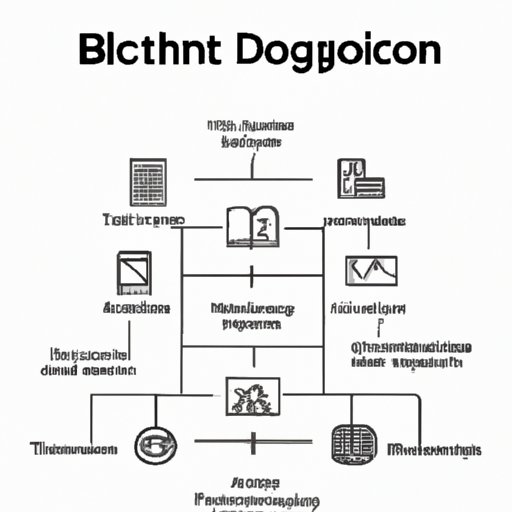Introduction
Blockchain technology has become one of the most talked-about topics in recent years. Although it has been around for some time, many people are still uncertain about its age and how long it has been in development. In this article, we will explore the history of blockchain technology and examine how it has evolved over the past decade.

Exploring the History of Blockchain Technology
In order to understand how old blockchain technology is, it is important to first look at its origins. The concept of blockchain was first proposed in 1991 by Stuart Haber and W. Scott Stornetta, two computer scientists who wanted to create a system for securely storing data on a distributed ledger. This was followed by the development of Bitcoin in 2008, which was the first application of blockchain technology.
Bitcoin quickly gained popularity, and within a few years, other cryptocurrencies began to emerge, such as Litecoin, Dogecoin, and Ethereum. These “altcoins” used the same basic principles as Bitcoin but had different features, such as faster transaction times or more efficient mining algorithms. As cryptocurrencies became more widely accepted, Initial Coin Offerings (ICOs) started to appear, allowing companies to raise funds by selling their own digital tokens.
A Timeline of Blockchain’s Evolution
Since its inception in 2008, blockchain technology has gone through several phases of development. Here is a timeline of some of the key events in its evolution:
- 2009 – Creation of Bitcoin: Satoshi Nakamoto publishes the whitepaper for Bitcoin, the world’s first cryptocurrency.
- 2011 – Rise of Ethereum: Vitalik Buterin releases the whitepaper for Ethereum, an open source platform for decentralized applications.
- 2013 – Emergence of Altcoins: Alternative cryptocurrencies, such as Litecoin, Dogecoin, and Peercoin, begin to appear.
- 2017 – ICO Boom: Companies start to raise funds through Initial Coin Offerings, selling their own digital tokens.

How Blockchain Has Evolved Over Time
Over the past decade, blockchain technology has seen significant advances in terms of security, transaction speed, and use cases. Security has been improved through the implementation of advanced cryptography, such as elliptic curve cryptography and zero-knowledge proofs. Transaction speeds have been increased through the use of off-chain scaling solutions, such as the Lightning Network and Plasma.
The use cases for blockchain technology have also expanded significantly. In addition to powering cryptocurrencies, blockchain is now being used for a variety of applications, such as smart contracts, digital identity management, supply chain tracking, and healthcare data management. There are even projects exploring the potential of blockchain technology for voting systems, energy trading, and music streaming.
The Age of Blockchain: How Long Has It Been Around?
The concept of blockchain technology was first proposed in 1991, but it wasn’t until the creation of Bitcoin in 2009 that the technology began to gain traction. Since then, blockchain technology has been rapidly evolving, with new developments occurring almost every year. We are now entering the second decade of blockchain technology, and its future is looking brighter than ever.

Examining the Maturity of Blockchain Technology
Despite the rapid pace of development, there is still much work to be done before blockchain technology can reach its full potential. Many of the current applications are still in their infancy, and there are still numerous challenges that need to be addressed, such as scalability, interoperability, and regulatory uncertainty. However, these issues are slowly being resolved, and the future looks promising for blockchain technology.
Comparing Different Generations of Blockchain Technologies
As blockchain technology has evolved, different generations of blockchain technologies have emerged. The first generation, represented by Bitcoin, is focused on providing a secure and decentralized form of money. The second generation, represented by Ethereum, is focused on enabling the development of decentralized applications. Finally, the third generation, represented by Hyperledger and Multichain, is focused on enterprise-grade blockchain solutions.
Conclusion
In conclusion, blockchain technology has come a long way since its inception in 1991. From its humble beginnings as a theoretical concept, it has grown into a powerful tool for transforming the way we manage data and conduct transactions. Despite the challenges that still remain, the future of blockchain technology is bright, and its impact on our lives is only just beginning.
Summary of the Article
This article explored the decade-long history of blockchain technology, from its early proposals to the emergence of Bitcoin and Ethereum, as well as its evolution in terms of security, transaction speed, and use cases. It also examined the maturity of blockchain technology and compared different generations of blockchain technologies. As the technology continues to advance, it is clear that blockchain has the potential to revolutionize the way we live and do business.
(Note: Is this article not meeting your expectations? Do you have knowledge or insights to share? Unlock new opportunities and expand your reach by joining our authors team. Click Registration to join us and share your expertise with our readers.)
